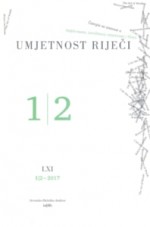Discipliniranje pripovjedne i čitateljske žudnje u romanu Kći Lotršćaka Marije Jurić Zagorke
DISCIPLINING NARRATIVE AND READER’S DESIRE IN THE DAUGHTER OF LOTRŠĆAK BY MARIJA JURIĆ ZAGORKA
Author(s): Nada KujundžićSubject(s): Croatian Literature
Published by: Hrvatsko filološko društvo
Keywords: the reader; serialised novel; The Daughter of Lotršćak/Kći Lotršćaka; Marija Jurić Zagorka; popular fiction; psychoanalytic criticism; romance;
Summary/Abstract: The paper explores the forms and functions of narrative desire in Marija Jurić Zagorka’s historical romance The Daughter of Lotršćak (Kći Lotršćaka). The primary focus is on the different forms of desire and their dynamics – both within the text (i.e. on the level of the story and characters), and between the text and the reader. Taking as its starting point the notion of an interdependence between the narrative (desire in the text) and the reader’s (desire for the text) desire, the paper explores ways in which the novel’s four protagonists (Divljan, Manduša, Šimun and Rosanda) are used to promote the disciplining of desire, and the sanctioning of its excessive and/or transgressive forms. Furthermore, the novel is interpreted as a site of instruction and promotion of the disciplining of the reader’s desire. This was especially prominent in the case of serialised fiction, which is the case with the initial publication of The Daughter of Lotršćak. The simultaneous generating and maintaining of desire, i.e. the continuous postponement of its gratification, is identified as the fundamental novelistic impulse on almost every level: formal (serialised novel), generic (romance), thematic (love story), and communicational (reader-response). The first part of the paper deals with narrative desire, which is exemplified with four central characters. The second part examines the reader’s desire in the context of the serialised novel and popular fiction in general. The paper uses the theoretical and methodological apparatus of psychoanalytic criticism, specifically Freud’s theories of desire, perversion and libidinal economy, as well as the theories of desire developed by Roland Barthes (2004) and Peter Brooks (1984).
Journal: Umjetnost riječi
- Issue Year: 2017
- Issue No: 1-2
- Page Range: 67-86
- Page Count: 20
- Language: Croatian

